Characteristics and properties of cabergoline
Pharmacokinetics
Absorption
Cabergoline is rapidly absorbed from the gastrointestinal tract, the maximum plasma concentration after a single oral dose of 0.5 mg to 1.5 mg is 30-70 pg/ml and is reached in 2-3 hours. The absolute bioavailability of cabergoline is unknown. Food intake does not affect the absorption and distribution of cabergoline.
Distribution
Binding to blood plasma proteins is 41-42%.
Metabolism
The major metabolite of cabergoline identified in the urine is 6-allyl-8β-carboxy-ergoline at concentrations up to 4-6% of the dose taken; the concentration of 3 additional metabolites is less than 3% of the dose. The metabolites have significantly less effect with respect to suppression of prolactin secretion compared with cabergoline.
Excretion
The half-life of cabergoline, estimated by the renal excretion rate, is 63-68 hours in healthy volunteers and 79-115 hours in patients with hyperprolactinaemia. Due to the long elimination half-life, the state of equilibrium concentration is reached after 4 weeks. In 10 days after cabergoline administration about 18% and 72% of the taken dose are found in urine and faeces, respectively, and the proportion of unchanged cabergoline in urine is 2-3%.
Pharmacodynamics
Cabergoline is a dopaminergic derivative of ergoline and is characterised by a pronounced and prolonged prolactinsensitising effect due to direct stimulation of D2-dopamine receptors of lactotropic cells of pituitary gland. In addition, when administered in higher doses compared to the doses to reduce plasma prolactin concentration, cabergoline has a central dopaminergic effect due to stimulation of D2-receptors.
Decrease in plasma prolactin concentration is noted within 3 h after the drug administration and persists for 7-28 days in healthy volunteers and patients with hyperprolactinaemia and up to 14-21 days – in women in the postpartum period. Cabergoline has a strictly selective action, has no effect on basal secretion of other pituitary hormones and cortisol. Prolactin-reducing effect of the drug is dose-dependent, both in terms of severity and duration of action.
The pharmacodynamic effects of cabergoline, unrelated to the therapeutic effect, include only a decrease in blood pressure (BP). With a single administration of the drug, the maximum hypotensive effect is observed during the first 6 hours and is dose-dependent.
Indications
- Prevention of physiological lactation after childbirth;
- suppression of already established postpartum lactation;
- treatment of disorders associated with hyperprolactinaemia, including amenorrhoea, oligomenorrhoea, anovulation, galactorrhoea;
- prolactin-secreting pituitary adenomas (micro- and macroprolactinomas); idiopathic hyperprolactinaemia; empty Turkish saddle syndrome in combination with hyperprolactinaemia.
Contraindications
- Hypersensitivity to cabergoline and/or any excipient in the composition of the drug, as well as any ergot alkaloids.
- Fibrotic changes in the lungs, pericardium or retroperitoneum in the anamnesis.
- In long-term therapy: anatomical signs of pathology of the heart valve apparatus (such as thickening of the valve leaflet, narrowing of the valve lumen, mixed pathology of valve narrowing and stenosis), confirmed by echocardiographic examination (echocardiography) performed at the beginning of therapy.
- Use in children and adolescents under 16 years of age (safety and efficacy of the drug have not been established).
- Lactose intolerance, lactase deficiency, glucose-galactose malabsorption.
- Pregnancy and period of breastfeeding (due to the lack of clinical data on the efficacy and safety of cabergoline).
With caution
As with other ergot derivatives, cabergoline should be administered with caution in the following conditions and/or diseases:
- arterial hypertension developed against the background of pregnancy, such as pre-eclampsia or postpartum arterial hypertension (cabergoline is prescribed only when the potential benefit of the drug significantly exceeds the possible risk);
- severe cardiovascular disease, Raynaud’s syndrome;
- peptic ulcer, gastrointestinal bleeding;
- severe hepatic insufficiency (lower doses are recommended);
- severe psychotic or cognitive disorders (including history);
- concomitant use with drugs with hypotensive effect (due to the risk of orthostatic arterial hypotension).
Use in pregnancy and lactation
Pregnancy
There have been no adequate controlled clinical studies on the use of cabergoline in pregnant women. Animal studies have not demonstrated teratogenic effects of cabergoline, but decreased fertility and embryotoxicity have been identified. Results of a 12-year observational study of the effects of cabergoline on pregnancy outcomes showed that in 6.6% (17 pregnancies out of 256) resulted in serious congenital malformations or premature termination of pregnancy (musculoskeletal, cardiac, and pulmonary malformations were the most common). There is no information regarding perinatal disorders or long-term follow-up of neonates whose mothers took cabergoline during pregnancy. Therefore, therapy with cabergoline during pregnancy is possible only if absolutely necessary, taking into account a careful assessment of the benefit-risk ratio for the woman and the foetus. Taking into account the long half-life of cabergoline and limited data on the effect of cabergoline on the foetus, patients planning pregnancy should stop its use one month before the planned date of pregnancy. In case of pregnancy on the background of cabergoline therapy, the drug should be discontinued after confirmation of pregnancy.
Period of breastfeeding
Cabergoline penetrates into milk of lactating rats, there is no information about penetration of cabergoline into human breast milk. However, breastfeeding should be discouraged if cabergoline is not sufficiently effective in preventing or inhibiting lactation.
Since cabergoline prevents lactation, administration of the drug is contraindicated in patients with hyperprolactinaemia who plan to breastfeed.
Special instructions
Before prescribing cabergoline for the treatment of disorders associated with hyperprolactinaemia, it is necessary to perform a complete examination of the pituitary gland.
Before prescribing cabergoline, cardiovascular evaluation should be performed, including EchoCG to detect asymptomatic valve dysfunction.
Cabergoline may cause symptomatic arterial hypotension, especially when co-administered with BP-lowering drugs. It is recommended to measure BP regularly in the first 3-4 days after the start of treatment.
Prolonged use of cabergoline and other ergot derivatives active against serotonin 5-NT2B receptors increases the risk of fibrotic and serous inflammatory diseases, such as exudative pleurisy, pleural fibrosis, pulmonary fibrosis, pericarditis, lesions of one or more heart valves (aortic, mitral, tricuspid), retroperitoneal fibrosis. Cancellation of cabergoline in case of development of the above pathology resulted in improvement of signs and symptoms.
Before starting long-term therapy with cabergoline, all patients should undergo a complete examination to detect heart valve damage, determine the functional status of the lungs and kidneys to prevent the worsening of concomitant diseases.
If new clinical symptoms appear on the part of the respiratory system, lung X-ray examination is recommended. In patients with pleural effusion/fibrosis elevation of COE was noted, therefore, in case of elevated COE without obvious clinical signs, radiological examination should also be performed.
During long-term therapy with cabergoline it is possible gradual development of fibrotic disorders, therefore during the treatment it is necessary to control the appearance of such symptoms as dyspnoea, shortening of breathing, cough, chest pain, low back pain, oedema of lower extremities, signs of retroperitoneal fibrosis, heart failure.
After the start of therapy with cabergoline in order to prevent fibrotic disorders, the condition of heart valves should be monitored and ECG examination should be performed for 3-6 months. Further the frequency of ECG monitoring is established by the doctor individually for each patient, but not less than once every 6-12 months. In case of appearance or worsening of valve regurgitation, narrowing of the lumen or thickening of the valve wall, therapy with cabergoline should be discontinued.
The patient’s need for other types of clinical examination is determined by the physician on an individual basis.
It is recommended that serum prolactin levels be checked every month, as normal prolactin levels persist for 2-4 weeks after an effective therapeutic regimen is achieved. After cancelling cabergoline, hyperprolactinaemia usually reoccurs. However, some patients experience a persistent decrease in prolactin concentration for several months.
Effect on the ability to drive vehicles and mechanisms
Cabergoline lowers BP, which may impair reaction speed in some patients. Patients receiving cabergoline should refrain from driving vehicles and other activities requiring high concentration and speed of psychomotor reactions.
Drug interaction
It is not recommended to use cabergoline concomitantly with macrolide antibiotics (including erythromycin), because the bioavailability of cabergoline and the severity of its side effects increase.
The mechanism of action of cabergoline is associated with direct stimulation of dopamine receptors, therefore it should not be used in combination with dopamine receptor antagonists (phenothiazines, butyrophenones, thioxanthenes, metoclopramide).
Combination with ergot alkaloids and their derivatives is not recommended.
Given the pharmacodynamics of cabergoline (hypotensive effect), it is necessary to take into account the interaction with BP-lowering drugs.
Showing 1–16 of 18 results
-
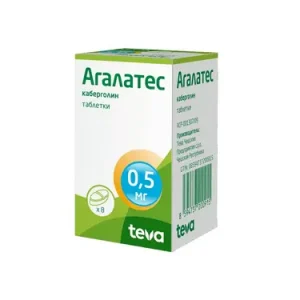
Agalates 0,5 mg (2 tab) TEVA
7,00 € Add to cart -

Agalates 0,5 mg (8 tab) TEVA
10,86 € Add to cart -

Bergolac 0,5 mg (2 tab) Veropharm LLC
5,00 € Add to cart -
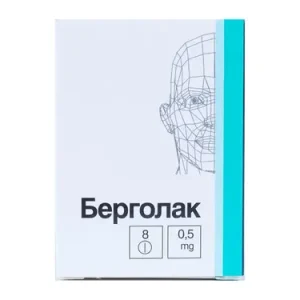
Bergolac 0,5 mg (8 tab) Veropharm LLC
25,80 € Add to cart -
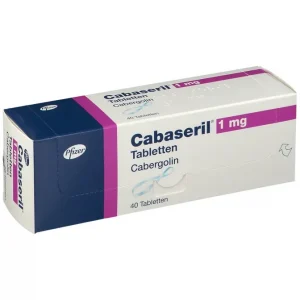
Cabaseril® 1 mg Pfizer
10,00 € Add to cart -
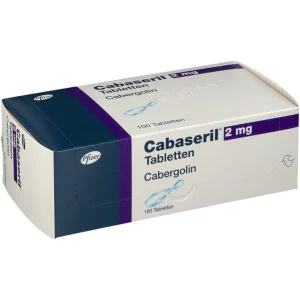
Cabaseril® 2 mg Pfizer
10,00 € Add to cart -

Cabergolin 0.5 mg (2 tab) Obninsk
4,00 € Add to cart -

Cabergolin 0.5 mg (8 tab) Obninsk
15,00 € Add to cart -

Cabergolin-ratiopharm® 0.5 mg
9,86 € Add to cart -

Cabergolin-ratiopharm® 1 mg
10,00 € Add to cart -
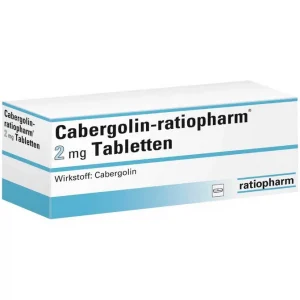
Cabergolin-ratiopharm® 2 mg
10,00 € Add to cart -

Cabergolin-TEVA® 0,5 mg
9,86 € Add to cart -

Cabergolin-TEVA® 1 mg
10,00 € Add to cart -

Cabergolin-TEVA® 2 mg Teva
10,00 € Add to cart -

Dostinex 0,5 mg (2 tab) Pfizer
9,00 € Add to cart -

Dostinex 0,5 mg (8 tab) Pfizer
22,75 € Add to cart